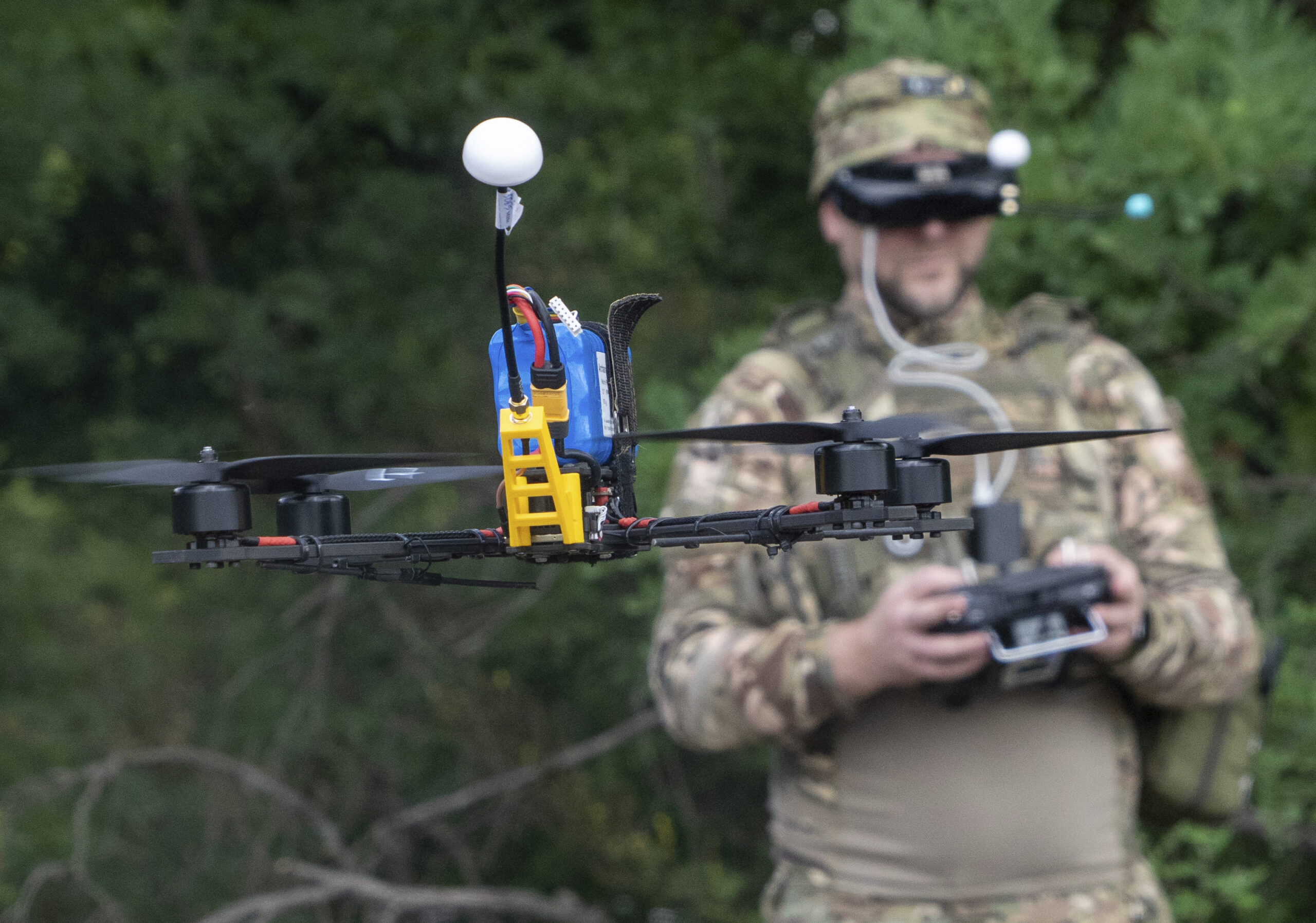World
Ukrainian Drone Unit Tackles Challenges in Modern Warfare

In a recent video interview, a member of Ukraine’s elite Typhoon unit shed light on the challenges faced by their drone operations in the ongoing conflict with Russia. Formed in 2024, this special forces unit within the Ukrainian National Guard specializes in unmanned systems, evolving from frontline first-person-view (FPV) operations to a broader range of unmanned aerial capabilities. Central to their efforts is training operators and enhancing drone technology for combat effectiveness.
The unit, represented by an analyst known only as “Alex” for security reasons, discussed significant issues such as pilot shortages and adapting to sophisticated electronic warfare tactics. According to Alex, the unit is currently grappling with a shortage of both pilots and motivated individuals, complicating their training efforts. “It takes at least three months to train pilots to a beginner level, particularly for FPVs,” he explained. “Pilots now also need to understand engineering principles to troubleshoot and repair drones in the field.”
Challenges in Training and Electronic Warfare
Alex emphasized the importance of quality over quantity in training. “We strive to provide fresh knowledge and battlefield analysis,” he noted, underscoring the need for pilots to adapt quickly to evolving electronic jamming systems deployed by Russian forces. By sharing real-time data on radio frequencies and jamming patterns, the unit aims to improve pilot effectiveness. “Even with fewer pilots, we ensure they are better trained and prepared,” he added.
The challenge of electronic warfare is immense, with Russian systems capable of covering a wide range of frequencies. Alex described how successful missions often depend on executing strikes before jamming systems activate. “If a pilot can hit a target in one shot, they can avoid detection,” he stated. “However, if they fail to do so, the jamming systems are likely to interfere.”
To counter these threats, the Typhoon unit has incorporated advanced technology, utilizing FPVs with multiple receivers and antennas to maintain control even under heavy jamming conditions. “Using diverse frequencies and antenna polarizations significantly increases the chances of maintaining a stable connection,” Alex explained.
Evaluating the Effectiveness of Unmanned Systems
When discussing the requirements for unmanned technologies, Alex noted a reliance on readily available spare parts, which has led to a focus on local production within Ukraine. “Having a variety of spare parts is crucial for success,” he asserted. “If we can quickly swap components, we can adapt to the battlefield’s changing conditions.”
The effectiveness of Western-made unmanned systems has also been a topic of discussion within the unit. Alex highlighted the success of fixed-wing reconnaissance drones, particularly the German-made Vector and Polish-made FlyEye. These systems are successful due to their ability to gather rapid feedback from operators on the ground, allowing for swift modifications. In contrast, some smaller drones have struggled to meet the demands of the battlefield, particularly in electronic warfare situations.
Alex recounted a troubling encounter with a European manufacturer of a fixed-wing strike drone that had not tested its product under conditions similar to those faced in Ukraine. “When they admitted they hadn’t tested it in jamming conditions, it raised significant concerns about its reliability,” he said.
The effectiveness of fiber-optic drones has also come under scrutiny. Alex noted that while these drones have increased their operational range—sometimes reaching up to 30 kilometers—they still face reliability issues with signal interruptions. He emphasized that any improvements in fiber-optic technology must focus on critical details, such as the quality of the fiber and the application of lubricants.
Ultimately, the success rates of FPV missions hinge on pilot skill. Alex estimated that highly skilled pilots achieve a success rate of approximately 70% to 80%, while novice operators may see success rates drop to as low as 20%. In contrast, fiber-optic drones have a success rate of around 40% to 50%, influenced by factors such as weather, artillery intensity, and the risk of severing the fiber-optic line.
The insights shared by Alex illustrate the complex landscape of modern warfare, highlighting the critical interplay between advanced technology, skilled operators, and the unforgiving realities of the battlefield. As Ukraine continues to adapt its drone capabilities in response to Russian tactics, the ongoing evolution of the Typhoon unit remains a focal point in the broader conflict.
-

 Science3 weeks ago
Science3 weeks agoIROS 2025 to Showcase Cutting-Edge Robotics Innovations in China
-

 Lifestyle3 weeks ago
Lifestyle3 weeks agoStone Island’s Logo Worn by Extremists Sparks Brand Dilemma
-

 World3 weeks ago
World3 weeks agoBravo Company Veterans Honored with Bronze Medals After 56 Years
-

 Politics3 weeks ago
Politics3 weeks agoJudge Considers Dismissal of Chelsea Housing Case Citing AI Flaws
-

 Health3 weeks ago
Health3 weeks agoStartup Liberate Bio Secures $31 Million for Next-Gen Therapies
-

 Health3 weeks ago
Health3 weeks agoTop Hyaluronic Acid Serums for Radiant Skin in 2025
-

 Top Stories3 weeks ago
Top Stories3 weeks agoIndonesia Suspends 27,000 Bank Accounts in Online Gambling Crackdown
-

 Sports3 weeks ago
Sports3 weeks agoMel Kiper Jr. Reveals Top 25 Prospects for 2026 NFL Draft
-

 Science3 weeks ago
Science3 weeks agoArizona State University Transforms Programming Education Approach
-

 Lifestyle3 weeks ago
Lifestyle3 weeks agoMary Morgan Jackson Crowned Little Miss National Peanut Festival 2025
-

 World3 weeks ago
World3 weeks agoHoneywell Predicts Record Demand for Business Jets Over Next Decade
-

 Sports3 weeks ago
Sports3 weeks agoYamamoto’s Mastery Leads Dodgers to 5-1 Victory in NLCS Game 2








